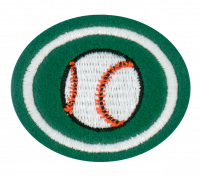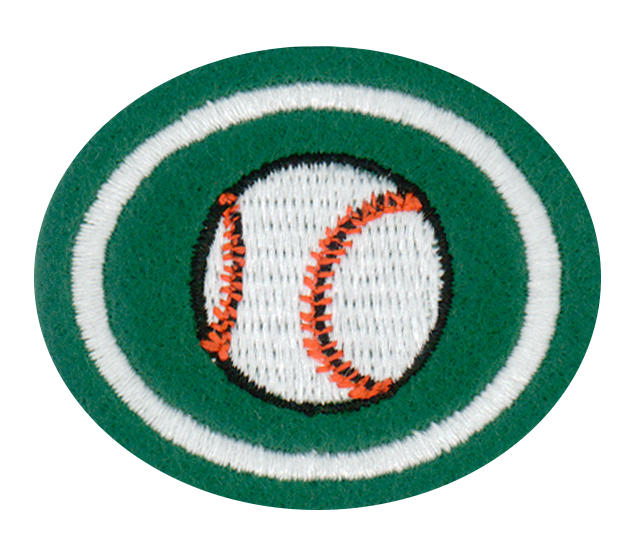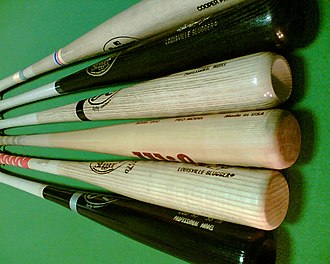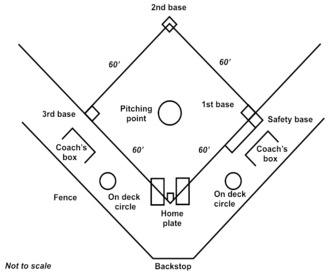AY Honors/Slow-Pitch Softball/Answer Key
1
Softball is a variant of baseball played with a larger ball on a smaller field. It was invented in 1887 in Chicago as an indoor game. It was at various times called indoor baseball, mush ball, playground, softbund ball, kitten ball, and, because it was also played by women, ladies' baseball. The name softball was given to the game in 1926.
There are two types of softball. In the most common type, slow-pitch softball, the ball, sometimes larger than the standard 12 inches, must arch on its path to the batter; there are 10 players in a team; and bunting and stealing are prohibited. In fast-pitch softball, the pitch is fast, there are 9 players on the field at one time, and bunting and stealing are permitted. Softball rules vary somewhat from those of baseball. Two major differences are that the ball must be pitched underhand—from 46 ft. for men or 43 ft. for women as compared with 60.5 ft. in baseball—and that seven innings instead of nine constitute a regulation game.
Despite the name, the ball used in softball is not very soft. It is about 11 or 12 in. in circumference for slow-pitch, which is 3 in. larger than a baseball. The infield in softball is smaller than on a baseball diamond; each base is 60 ft. from the next, as opposed to baseball's 90 ft.
2
Good sportsmanship means having good conduct and attitude by sports participants, especially fair play, courtesy, striving spirit, and grace in losing. A good sport will not gloat when he wins, nor will he sulk when he loses. He will offer help to his opponent, even if doing so may cost him a win. He will understand that his opponent is more important than the contest.
3
Infield
- pitcher
- catcher
- first baseman
- second baseman
- shortstop
- third baseman
Outfield
- left fielder
- center fielder
- right fielder
- rover
- In slow pitch softball there is an extra fielder, who is specified as a rover. Normally, the defensive team will play with four outfielders, meaning there is a left fielder, left-center fielder, right-center fielder, and right fielder.
4
4a
The bat used by the batter can be made of metal, wood, or composite materials (carbon fiber, etc.). Sizes may vary but they may be no more than 86 cm in length, 6 cm in diameter, or 38 oz. in weight. The Slowpitch softball bat barrel standard is 2 1/4 inches. Many players prefer a smaller barrel that lightens weight and provides more swing speed.
4b
The "on deck circle" is a circle outside the field of play where the next batter stands while waiting for a turn to bat. The next player to bat is said to be "on deck."
4c
The batter's box is a rectangle in which the batter stands while at bat. There are two batter's boxes on a softball diamond, one on either side of home plate. This allows a hitter to stand on either side of home pate, a choice often made depending on the batter's handedness.
4d
The outfield is the area of the softball diamond beyond the baselines (which are the lanes between the bases).
4e
The coaches' box is a rectangular area outside the field of play. A softball diamond has two of them, with one situated near first base, and another near third base. The base coaches stand in these to offer instruction and advice to the runners.
4f
The pitcher's mound is a raised area in the center of the infield. The pitcher stands on the mound when pitching.
4g
Diamond bag is another word for base. There are three of them, designated first, second, and third base.
4h
The pitching rubber is a strip of rubber located on the pitcher's mound. The pitcher's foot must be in contact with the pitching rubber when the pitch is made.
4i
All defensive players wear fielding gloves, made of leather or similar material. Gloves have webbing between the thumb and forefinger, known as the "pocket". The first baseman and the catcher may wear mitts; mitts are distinguished from gloves in that they have extra padding, and no fingers. Gloves used in softball are generally larger than the ones used in baseball.
4j
4k
4l
4m
4n
5
5a
This is when there are fewer than 3 outs and there are base runners on first, second, and third. In this situation, all runners are prepared to run when the ball is hit. If there are two outs, all runners will "run on contact," when the ball is hit by the hitter.
5b
The home team is the team who is playing on their own field, and the other team is visiting from another school or town. Alternately, the home team is randomly chosen in some fashion. That is because, in many leagues, all teams are from one region and players have been randomly assigned by the league. In this second case, the home team is simply the team that bats in the bottom of the inning. In this case, home team is usually chosen by a coin toss at the beginning of the game or has been decided by the league scheduling office prior to the beginning of the season. On a scoreboard, the home team always appears second and bats in the bottom of each inning.
5c
A bunt is not legal in most slow-pitch softball leagues. If allowed, it is performed by the batter moving his/her upper hand up the stock of the bat, bringing the bat parallel to the ground as it makes contact with the ball. The goal is for the ball to drop mere inches in front of the plate, thus forcing the fielders to make the "sure out" at first and advance the other base runners. It is a tactical move that is better suited to the expertise of players in fast-pitch leagues. Also, since most slow-pitch softball games require a 6' arc pitch, a bunt is nearly impossible.
5d
An inning is composed of a top and a bottom of the inning. During the top of the inning the visiting team bats until they make three outs. In the bottom of the inning the home team bats until them make three outs. Most slow-pitch softball games have seven-innings. However, there are other rules (that are common to most leagues--check your local league's rules) that may limit the number of innings played such as:
1. No inning may begin after the one-hour of play has ended
2. If one team is leading by 15+ runs after 3 innings or 10+ runs after 5 innings, the game is called (ended). This is often called the "mercy rule."
5e
This term is used to calculate earned runs and the like. It means that the defense had a choice of whether to get the batter out at first, or to get another base-runner out on second, third or home, and chose to get the base-runner out rather than the batter. This term is not used much in slow-pitch softball.
5f
This is a list of the players on a team and the ORDER in which they bat. In many slow-pitch softball leagues, all players on a team hit, regardless of whether they are part of the 10-man-field. In many leagues, a team is allowed to play the game with only 8 of their 10-person field players present. However, when there are less than 10 batters, an out is taken whenever those spots come up in the rotation. In most cases, if a player arrives late they can ONLY be inserted in the lineup at the bottom of the lineup. Thus, if your "#3 hitter" shows up after the game has started, he/she can't hit where you strategically like him/her to. Instead he/she bats at the bottom of the lineup.
5g
5h
5i
5j
5k
This occurs when the batter swings at a pitch and makes contact with the ball. However, the ball does not "land" between the lines (the field area), but instead flies far left, far right, or behind the batter, and thus not in the field of play. After the player has received a second strike, he/she is allowed a "courtesy foul" but if he/she fouls a second time (after the second strike), he/she is called out. If a foul tip is caught by a fielder (usually the catcher or infielder), he/she is called out.
5l
The score is usually displayed on a scoreboard, but at least is recorded by each team and returned to the officials. The score is the summation of the number of runs scored by each team throughout the game. At the end of the game, the team with the highest score (the most runs scored) wins the game.
5m
A home run (HR) with runners on all three bases prior to the home run. Thus, the home run results in four RBIs for the hitter and 4 runs scored for the team.
5n
The area between the shoulders and knees of the batter that is the width of the home plate (thus a rectangular area). A pitch delivered through this zone is considered a strike.
In most leagues, a player enters the batters box with one strike and one ball (to speed up the game), and thus, two more strikes either swung at or called strikes result in an out.
5o
5p
5q
5r
6
6a
6b
6c
6d
6e
6f
6g
6h
7
8
- Call balls and strikes -- The homebase umpire is responsible to indicate to the players how many balls and strikes the current batter has accumulated.
- Call foul/fair balls "down the lines" -- The umpire is responsible to indicate with proper signaling whether a ball hit to the right or left is a "fair" ball (and thus playable) or "foul" ball (and thus cannot be run/scored upon).
- Call base-runners safe/out -- Once the ball is in play, the umpire is responsible for determining whether the runners successfully tagged and maintained contact with the bases around the basepath ahead of the fielders play or whether the fielder was able to put the runner "out" by force or by tagging the non-forced runner.
- Call double plays and other fielding outs -- Once the ball is in play, the umpire is responsible for determining whether a hit ball was caught by the fielder and whether he/she maintained control of that ball throughout the play. When calling double plays the umpire is responsible for seeing that the ball arrived at the first put out location (usually second) prior to the baserunner, then was relayed to the second put out location (usually first) and arrived prior to the baserunner.
- Call the start and end of the game -- Umpires must make sure games begin and end on time
- Recording / tracking scorecards & Lineups -- Umpires guard the integrity of the game by being sure that the scores recorded are valid and that the lineups were legitimate throughout the game's play.
9
- Eye-hand coordination
- Concentration
- Strategic play (both offensively and defensively)
- Teamwork (the ability to communicate with and work with other players for the common goal of winning the game and playing well)
- Placement and control (pitcher & catcher especially)
10
10a
10b
10c
11
Batter up! Have fun.
12
We would encourage you to limiting your report to one page about a famous baseball/softball athlete.
Olympic baseball, Olympic women's softball, Major League Baseball, the Negro Leagues (historical),
Wikipedia List of Professional Baseball Leagues, and Baseball Hall of Fame] may give you some ideas.
Remember that not all super stars are admirable Christian role models. Many have abused alcohol, performance enhancing drugs, etc. In addition, many have used sports as an excuse to live lives not in keeping with the 10 Commandments, especially commandments #7 and #10 ("Thou shalt not commit adultery" and "Thou shalt not covet.") However, as in most walks of life, there are heroes that not only stand out professionally as the best in their field, but who also live model lives that Christian young people can admire.
REMEMBER, this is ONLY a ONE PAGE report.
Please practice honesty by NOT simply cut-and-pasting a Wikipedia biography into a word document. Your paper should show thought and highlight the question asked in this requirement.
13
The most obvious problem faced by a Seventh-day Adventist who wishes to participate in organized sports is the tendency for games to be scheduled during Sabbath hours. Competitive sports and Sabbath observance are often not compatible with one another. Another challenge at higher levels is pressure to take performance enhancing drugs (doping).
An alternative that avoids Sabbath breaking or drug pressure would be to participate with a group of like-minded individuals. Many towns offer city leagues, and it may be possible to form a team with other members of your church, with the understanding that you will not compete on the Sabbath. The Adventist athlete may also enjoy individual sports instead, or engage in informal pick-up games. A student choosing an Adventist University or College which offers team sports programs is unlikely to experience Sabbath difficulties.
As Christians we need to show Christ-like behavior on the field. Always play fair and be a good sport. Don't trash talk other teams or players. It is OK to try to win, but not in any way that degrades or sets a bad example.
References
Mark O'Ffill is the author of the answers for the "Slow Pitch Softball Requirements" and also was responsible for taking several editions of differing proposed honor requirements and submitting one united honor proposal to the Honors Taskforce. At the time this article was written, Mark was a teacher at Hilltop Christian School in Antioch, CA, where he taught PE to grades 3-10, in addition to History and Bible classes for grades 7-10.





